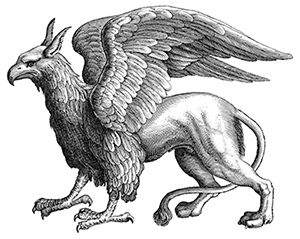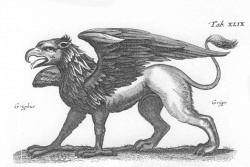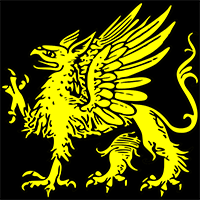
Introduction by Joe Nigg
The Gryphon (griffin, etc.) is one of the oldest and most complex hybrid animals the human imagination has reshaped from nature. Arising in Middle Eastern art 5,000 years ago, the feline and avian mythical beast has evolved through art and story in multiple forms and contradictory characteristics throughout its long, rich history. At times a loyal guardian or a fierce predator, it pulled divine chariots, attacked horses and other animals, was regarded as evil or divine, and became a majestic charge on coats of arms. It is now all around us, from business logos and products to all types of fantasy media. Its names appear in hundreds of millions of Web search matches.
The comprehensive, newly designed Gryphon Pages stands apart from the many online sites that profile the eagle-lion beast along with other mythical creatures. The site is a personal Gryphon Quest. Site creator James Spaid became a devoted follower of the Gryphon more than 20 years ago and has been developing his website ever since.
His eclectic study is widely researched, with an extensive bibliography, maps, literary timeline, period illustrations, and links. Site sections detail all aspects of the millennia-old beast, including a highlight essay on the heraldic Gryphon. The site’s future exploration of the Gryphon’s complex nature will include the current controversy regarding the fantastic animal’s origin: whether it was inspired by the discovery of paleolithic fossils or by independent imagination.
The Gryphon Pages invites other followers of the Gryphon to join the Quest.
––Joe Nigg, The Book of Gryphons

What is a Gryphon?
When we think of gryphons today, the most common image is that of a winged golden brown four legged animal, lion-like in the hindquarters, with an aquiline head and forelegs. Yet this image, popularized in Western heraldry, is only one of many descriptions of gryphons throughout the years! The first known image of a gryphon, found on a seal dating back to 3,000 BC in Iran, shows the general outline of that four legged animal with eagle wings, forelegs, and head. The first written description of a gryphon, however, comes from Ctesias in the 5th century BC, where he writes that the gold in the mountains of India is guarded by gryphons. "These are birds with four legs, of the size of a wolf, with the legs and claws of a lion, having red feathers on the breast, but black on the rest of the body." Read more...

Where do Gryphons Come From?
The myth of the Gryphon just gets more and more confusing, doesn't it? As if multiple forms and multiple names weren't enough, there are also a multitude of places where the Gryphon is said to have come from. Read more...

Gryphons in Literature
Throughout time men have marveled at the world around them and it's vast wealth of creatures, lands and cultures. Fortunately for us, there were those who were wise enough to know that should future generations ever wish to behold what they have seen, it must be written down and chronicled. Many authors however, have tried to pass off fiction as truth, and then there are those who try to copy those before them, and present the work as their own. One man writes of a lie as though it were true. Then another man comes, reads the lie, and tries to pass it off as his truth, embellishing the original lie to make it seem more like his own, then another man comes, and so on turns this vicious circle. Read more...

Gryphons in Heraldry
Being the regal and highly emblematic creature that it was, there is no surprise that the Gryphon quickly became associated with the symbolic art of Heraldry. In fact, the Gryphon is the most widely used "monster" in heraldry, just as the lion is the most widely used beast and the eagle the most widely used bird. Read more...
© 2018 James Spaid. All rights reserved.